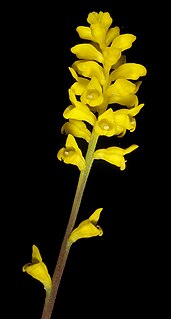
Hakea petiolaris, commonly known as the sea-urchin hakea, is a shrub or small tree with cream-coloured and pink or purple flowers and woody fruit. It is endemic to the south west of Australia, occurring at the coastal plain, jarrah forest and wheatbelt regions, often at the ancient granite outcrops of Western Australia.

Synaphea is a genus of small shrubs and is endemic to Western Australia. Synapheas have variably shaped leaves but consistently yellow flowers with an unusual pollination mechanism.

Synaphea spinulosa is a species of small shrub in the flowering plant family Proteaceae. It is endemic to Western Australia. Together with Acacia truncata, it was the first Australian endemic to be scientifically described and named, and the specimen upon which that description is based is the oldest extant specimen of an Australian plant, and very likely among the first Australian plant specimens ever collected.
Synaphea polymorpha, commonly known as Albany synaphea, is a species of small shrub in the flowering plant family Proteaceae. It is endemic to Western Australia. The Noongar peoples know the plant as bindak.
Synaphea acutiloba, commonly known as granite synaphea, is a shrub endemic to Western Australia.
Synaphea aephynsa is a shrub endemic to Western Australia.
Synaphea bifurcata is a shrub endemic to Western Australia.
Synaphea canaliculata is a shrub endemic to Western Australia.
Synaphea diabolica is a shrub endemic to Western Australia.
Synaphea divaricata is a shrub endemic to Western Australia.

Synaphea grandis is a shrub in the Proteaceae family, endemic to Western Australia.
Synaphea hians is a shrub endemic to Western Australia.
Synaphea lesueurensis is a shrub endemic to Western Australia.
Synaphea media is a shrub endemic to Western Australia.
Synaphea obtusata is a shrub endemic to Western Australia.
Synaphea odocoileops is a shrub endemic to Western Australia.
Synaphea oligantha is a shrub endemic to Western Australia.
Synaphea sparsiflora is a shrub endemic to Western Australia.
Synaphea stenoloba is a shrub endemic to Western Australia.
Synaphea xela is a shrub endemic to Western Australia.


